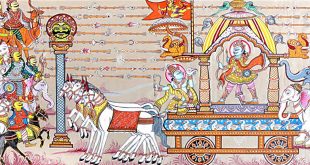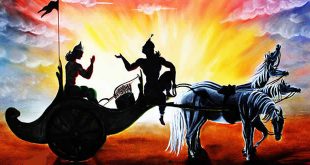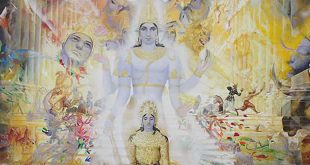Ksetra Ksetrajna Vibhaga Yoga-Bhagavad Gita Chapter 13 [The Individual and the Ultimate Consiousness]
Krishna Said > Shaloka: 1
![Ksetra Ksetrajna Vibhaga Yoga-Bhagavad Gita [Chapter: 13 - Verse 1]](https://www.4to40.com/wp-content/uploads/2015/01/13_shaloka_01.gif)
English
O my dear Krishna, I wish to know about prakrti [nature], purusa [the enjoyer], and the field and the knower of the field, and of knowledge and the end of knowledge. The Blessed Lord then said: This body, O son of Kunti, is called the field, and one who knows this body is called the knower of the field.
Purport
Arjuna was inquisitive about prakrtil, or nature, purusa, the enjoyer, ksetra, the field, ksetra-jna, its knower, and of knowledge and the object of knowledge. When he inquired about all these, Krishna said that this body is called the field and that one who knows this body is called the knower of the field. This body is the field of activity for the conditioned soul. The conditioned soul is entrapped in material existence, and he attempts to lord over material nature. And so, according to his capacity to dominate material nature, he gets a field of activity. That field of activity is the body. And what is the body? The body is made of senses. The conditioned soul wants to enjoy sense gratification, and, according to his capacity to enjoy sense gratification, he is offered a body, or field of activity. Therefore the body is called ksetra, or the field of activity for the conditioned soul. Now, the person who identifies himself with the body is called ksetra-jna, the knower of the field. It is not very difficult to understand the difference between the field and its knower, the body and the knower of the body. Any person can consider that from childhood to old age he undergoes so many changes of body and yet is still one person, remaining. Thus there is a difference between the knower of the field of activities and the actual field of activities. A living conditioned soul can thus understand that he is different from the body. It is described in the beginning–dehino ‘smin–that the living entity is within the body and that the body is changing from childhood to boyhood and from boyhood to youth and from youth to old age, and the person who owns the body knows that the body is changing. The owner is distinctly ksetrajna. Sometimes we understand that I am happy, I am a mad, I am a woman, I am a dog, I am a cat: these are the knowers. The knower is different from the field. Although we use many articles–our clothes, etc.–we know that we are different from the things used. Similarly, we also understand by a little contemplation that we are different from the body.
In the first six chapters of Bhagavad-gita, the knower of the body, the living entity, and the position by which he can understand the Supreme Lord are described. In the middle six chapters of the Gita, the Supreme Personality of Godhead and the relationship between the individual soul and the Supersoul in regard to devotional service are described. The superior position of the Supreme Personality of Godhead and the subordinate position of the individual soul are definitely defined in these chapters. The living entities are subordinate under all circumstances, but in their forgetfulness they are suffering. When enlightened by pious activities, they approach the Supreme Lord in different capacities–as the distressed, those in want of money, the inquisitive, and those in search of knowledge. That is also described. Now, starting with the Thirteenth Chapter, how the living entity comes in contact with material nature, how he is delivered by the Supreme Lord through the different methods of fruitive activities, cultivation of knowledge, and the discharge of devotional service are explained. Although the living entity is completely different from the material body, he somehow becomes related. This also is explained.
Hindi
![Ksetra Ksetrajna Vibhaga Yoga-Bhagavad Gita [Chapter: 13 - Verse 1]](https://www.4to40.com/wp-content/uploads/2015/01/13_shaloka_01_hindi.gif)
Punjabi
![Ksetra Ksetrajna Vibhaga Yoga-Bhagavad Gita [Chapter: 13 - Verse 1]](https://www.4to40.com/wp-content/uploads/2015/01/13_shaloka_01_punjabi.gif)
 Kids Portal For Parents India Kids Network
Kids Portal For Parents India Kids Network



